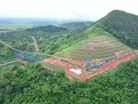Vale moves ahead with the S11D project following mining licence approval

Brazilian mining giant Vale has announced that it has obtained the operating mining licence for its S11D mine and plant, the largest iron ore project in the company’s history and the in the history of mining.
The company announced the licence last week which will be valid for 10 years from the Ibama environmental agency after it verified the compliance of the actions and envrionmetnal control mesures executred by Vale during the installation licence.
Here’s what we know about the S11D project:
Consisting of a mine and plant, S11D is located in Canaa dos Carahas, southeast Para.
The project will officially commence commercial operations in January 2017.
Vale will install an iron ore mine and processing plant, with three production lines - each one able to process 30 million metric tons per year.
The project name comes from its location: block D of ore body S11, which lies in the Southern Hills of Carajás. To the north is Carajás Mine, operating since 1985 in the neighbouring municipality of Parauapebas.
S11D is one block of an ore body, which has been divided up into four parts: A, B, C and D. The mineral potential of the S11 ore body is 10 billion metric tons of iron ore, of which blocks C and D alone possesses reserves of 4.24 billion metric tons.
Drilling in the region originally took place in the 1970s. At the turn of the century, the first technical capacity and financial viability studies were carried out, which led to the project's present configuration.
The project's preliminary licence was issued in June 2012 and its installation licence was obtained one year later. The mine's lifespan is currently estimated to be 48 years.
In total, around $16 – 17 billion will be invested in the S11D iron Project, with $6.8billion dedicated to the installation of the mine and plant.
Once fully operational, the project is expected to produce 90 million metric tonnes of iron ore.
When S11D hits full operating capacity, it is expected to bring Vale’s total iron ore production in Para up to 230 million metric tonnes per year, a significant increase from its current 109 million.
S11D will boast a 93 percent reduction in water consumption when compared to the conventional process of other mine sites, with 86 percent of water captured on site to be reused.
Vale is expecting to bring about 2,600 long-term jobs in the region.
The December issue of Mining Global is live!
Follow @MiningGlobal
Get in touch with our editor Dale Benton at [email protected]
- Onslow Iron's first transhipper launchedSupply Chain & Operations
- Vale appoints sustainability chief for energy transitionSupply Chain & Operations
- Vale tests battery powered trucks in Brazil and IndonesiaSustainability
- US SEC charges Vale with false claims over dams safetySupply Chain & Operations



